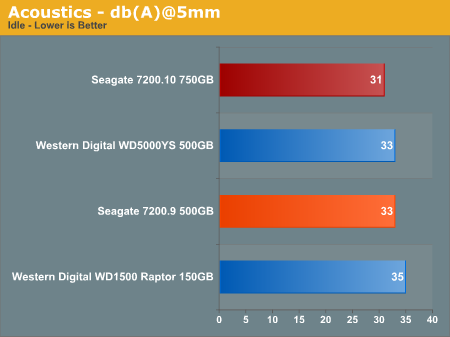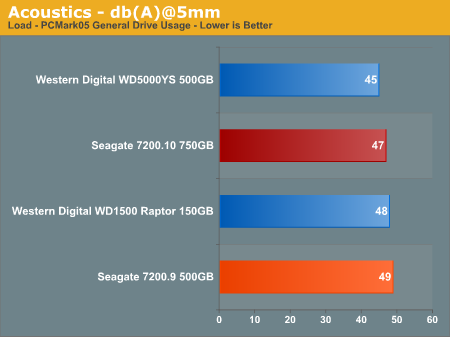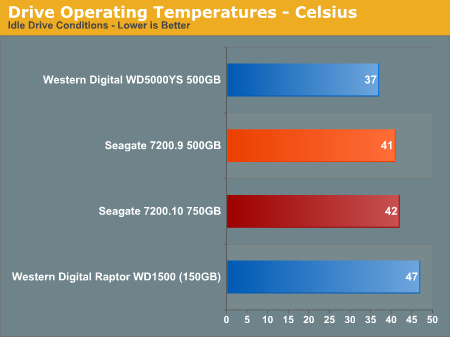Seagate Barracuda 7200.10 750GB: Size Does Matter
by Gary Key on May 18, 2006 9:00 AM EST- Posted in
- Storage
Acoustics
We have revised our acoustics testing methodology. Our acoustic test utilizes our standard test bed components but we implement AMD's Cool'n'Quiet technology and turn off the case fans to isolate as much case noise as possible during testing. Our OCZ power supply is virtually silent in these tests along with our fanless Asus 7600GS video card providing a further decrease in our case's ambient noise levels.Our acoustic tests are designed to measure the decibel levels while the system is at idle and also under load while running the General Hard Disk Drive Usage benchmark within PCMark 2005. We found through trail and error this particular benchmark produces controlled readings across a wide range of applications within the benchmark. This particular benchmark utilizes 60% reads and 40% writes within the trace playback file.
The measurements are taken at a distance of 5 millimeters from the rear and front of the drive being tested in order to minimize surrounding environmental noise. (Obviously, you won't have your head less than a centimeter away from the hard drive in normal computer use, but the important thing is the relative noise levels at this distance.) The reported measurements are based on an A-weighted decibel score that measures frequencies similar to the way the human ear responds to sound. We take a total of three measurements for each test. We then subtract the high and low scores and arrive at our findings by reporting the remaining score.


Seagate has advertised that the 7200.10 product is quieter in comparison to Barracuda 7200.9 in both idle and seek modes due to further refinements in their "Softsonic" motor technology. During our testing we came to a slightly different conclusion based upon our subjective test methodology. We found the 7200.10 drive recorded slightly better acoustic results in the instrument testing than the Seagate 7200.9 500GB drive but was subjectively louder than the 7200.9 500GB drive under load and almost matched our WD1500 Raptor in its very audible tone during full read requests.
This was surprising as the 7200.10 had the lowest idle rate of 31dBA in testing with full load tests generating a noticeable but not earth shattering 47dBA. The drive is basically a "silent" component in our case during idle conditions with only the occasional disc whirling but at full load the drive does generate a noticeable, almost thumping sound. In fact, although two of the drives tested are considered louder by our test equipment, the noise tone was slightly heavier which elicited our immediate attention to it. Of course, tone comments are generally very subjective so this drive could be considered quiet at full load when compared to other drives.
Thermals
Our thermal tests utilize sensor readings via the S.M.A.R.T. (Self-Monitoring, Analysis and Reporting Technology) capability of the drives and are reported by utilizing the Active SMART 2.42 utility. We test our drives in an enclosed case environment without the front fan operational to simulate temperatures that could conceivably be reached in a SFF or HTPC case design. We typically find the reported numbers drop anywhere from 18% to 25% on average when the front fan is operational.

We expected the 750GB 7200.10 drive to run very warm due to its size and platter count. The drive ran cooler than we expected, but the casing did become very warm to the touch - almost hot actually - which had us concerned until we noticed the reported numbers. Using the drive's integrated SMART thermal sensor and Active SMART we were able to monitor temperatures that went from 42°C at idle to 55°C under full load. These results were recorded in our enclosed Gigabyte case without the front fan operating to simulate the effects of utilizing drive in a small enclosure for HTPC duties or possibly a poorly ventilated case.
We then activated the 120mm fan in the front of the case and watched the full load temps quickly drop to 44°C and after a cool down period of 15 minutes the idle temps dropped to 37°C with full load testing resulting in 47°C readings. We would highly recommend some type of cooling in front of the drive, especially in a SFF or HTPC case. Though the temperatures we reached without a fan are well within the operating range of the drive, it is always preferable to keep hard drives cool to prolong their life, especially at a $500 price point.
The surprise showing once again is the Western Digital WD5000YS drive with reported temperatures at idle of 37°C and 45°C at full load. The WD Raptor 1500 has the ability to sizzle some bacon with idle temps at 47°C and full load at 58°C with a hardy recommendation of adding a fan directly in front of this unit. The Seagate 7200.9 500GB falls in the middle of the pack with temps at idle of 41°C and under full load at 53°C. While the temperatures of the 7200.9 in our testing show an advantage without cooling, the drive actually ran hotter than the 7200.10 when both were cooled with the front case fan. Our recorded temperatures after the same cool down period (ambient room temp equal) resulted in 38°C readings at idle and 49°C readings at full load.










44 Comments
View All Comments
Gary Key - Thursday, May 18, 2006 - link
The charts have been changed. :)
VooDooAddict - Thursday, May 18, 2006 - link
I like the "db(A)@5mm" sugestion.FallenDeathAngel - Thursday, May 18, 2006 - link
The RaptorWD1500ADFD Western Digital
Raptor
WD5000YS
Yes....
SpaceRanger - Thursday, May 18, 2006 - link
That the only drive you tested in RAID-0, was the new Seagate drive. The performace charts are kinda useless when the RAID-0 scores are included, cause it misleadingly shows the Seagate drive on top of a good portion of them. Without examples of RAID-0 performance from the WD1500 Raptor, or the WD5000YS, you are giving the impression of favoritism towards the Seagate drive.Gary Key - Thursday, May 18, 2006 - link
Good Day....from page 5-
We are providing RAID 0 results for the Seagate 7200.10 for comparative results to the single drive. Seagate has recently released updated firmware for the 500GB 7200.9 that improves RAID performance; unfortunately we were unable to complete our testing with the new firmware before publication. Our RAID results for the WD1500 series will be published in our next storage article.
We will have RAID O results for both of these drives in the 500GB roundup. We are not tyring to show favoritism towards the Seagate drive. Our comments are quite clear about the effects of RAID 0 in the I/O operations that while interesting, they do not always translate to actual 1:1 improvements in application usage. Our application timing tests bear this out to some degree.
We debated on showing the Seagate RAID 0 results as it is a no win situation. I am sure based upon the comments from our last couple of reviews that about as many people would be asking why we did not provide RAID 0 results. We are currently completing the RAID 0 results with the WD1500 drives, we ran into a couple of issues that required technical conversations with WD. Also, the sheer scope of testing every drive in RAID configurations is extremely time consuming with results that are basically the same when compared to the single drive scores.
My personal opinion is that RAID 0 is only effective in such a limited scope of applications that we should not report it at all. However, this feature has been pushed by the core logic chipset suppliers, marketed by the motherboard suppliers, and eventually becomes a test request by the user community. I would much rather show the benefits of RAID 5, 0+1, 10 in a separate article, which we will in the future. It is difficult at times to procure three samples of each drive. ;-)
I appreciate your comments, they will probably not be the last on this subject.
srk052004 - Thursday, May 25, 2006 - link
Hi Gary (and all). I have been told that for my purposes (manipulating 40gb SAS or SPSS data sets), RAID 0 really would be appropriate. Do you agree? Or, would you say that RAID 10 would still be preferable?I, too, would LOVE to see results comparing different capacities of 7200.10.
BTW, this was an interesting review.
SpaceRanger - Thursday, May 18, 2006 - link
Thank you for the quick response :)If you wants to show the comparision between RAID-0 and the Single drive, then have seperate charts showing just those 2. It makes the analysis of the performance much easier.
Now THAT'S an article I'd love to read as well!
Zoomer - Friday, May 26, 2006 - link
Ditto. It would be a nice way to split up articles into _more_ managable chunks of work!Thanks for the review! Will be looking forward to the ibm (hitachi), seagate and WD shootout.
Gary Key - Saturday, June 24, 2006 - link
We will change our format in July with the 500GB and 250~320GB roundups. I too would like to manage the chunks of work in different fashion.Questar - Thursday, May 18, 2006 - link
Then what was different than what Seagate claimed?